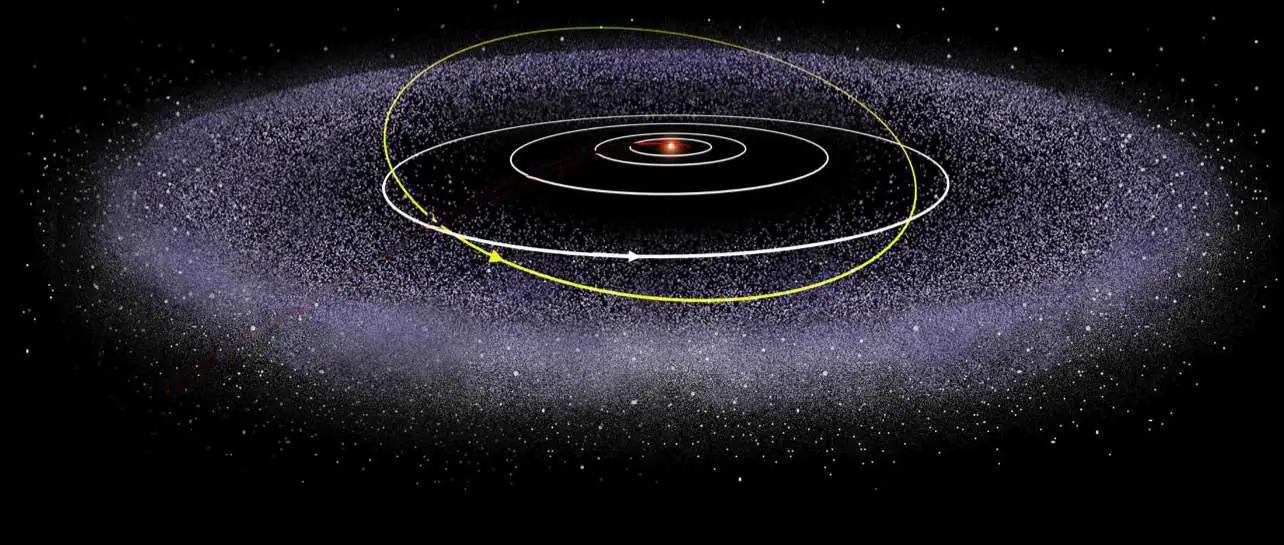An incredible new animation reveals the sheer number of alien worlds that may exist beyond the orbit of Pluto. The astronomer who compiled the data has said that it only illustrates a few dwarf planets hidden in the outermost reaches of our solar system.
Officially speaking, our solar system has eight ‘cosmic members’: Mercury, Venus, Earth, Mars, Jupiter, Saturn, Uranus, and Neptune. However, beyond Neptune we have all-star ‘dwarf planet Pluto. Now, astronomers suggest that Pluto is one of the many worlds located in the region called the Kuiper Belt.
The animation first spotted in a Reddit post by user Nobilitie, and later shared by the Business insider is in fact a recording of a ‘physics-based’ simulator gamer called “Universe Sandbox 2,” according to Dan Dixon, the creator, and director of the software.
Each of the orbits—depicted as whitish rings—represent an object. The countless rings located beyond the eight inner rings are attributed to dwarf planets like Pluto.
According to a post on Reddit, the orbits of the dwarf planet candidates were based on a constantly updated list of celestial objects.
Interestingly, this fascinating list is maintained by Mike Brown, an astronomer at the California Institute of Technology.
“It’s a nice illustration of what is out there,” Brown wrote in an email to Business Insider. “The striking difference between the orderly giant planets and the randomness of the dwarf planets is quite apparent.”
Mike Brown is the man behind the discovery of Eris, a celestial object that is 27 percent more massive than Pluto. Curiously, it was the discovery of Eris that degraded Pluto from a planet to a Dwarf planet.
As reported by the Business Insider, Pluto, Eris, Ceres, Makemake, Haumea, and five others meet Brown’s “near certainty” criteria — in other words, they’re definitely dwarf planets and not comets or other astronomical objects. Thirty are “highly likely” to be dwarf planets, 75 are “likely,” and nearly 850 are “probably” or “possibly” dwarf planets.
As the mind-bending animation illustrates, alien worlds orbiting our sun beyond Pluto may number in thousands.
Mike brown, together with Konstantin Batygin discovered evidence of a massive object—nearly the size of Neptune—beyond the orbit of Pluto. This celestial body has been referred to as Planet X, or planet nine. The scientific duo from the California Institute of Technology (Caltech) in Pasadena argue that Planet Nine orbits the sun every 15,000 years.
This alien world—which has still not been observed directly—has a mass about 10 times that of Earth and orbits about 20 times farther from the sun on average than does Neptune (which orbits the sun at an average distance of 2.8 billion miles).
According to Caltech, it would take this new planet between 10,000 and 20,000 years to make just one full orbit around the sun.
However, not only could there be a massive alien world beyond Neptune and Pluto, Brown estimates there may be thousands of dwarf planets out there.
“As you can see from the illustration, some of them are on exceedingly elliptical orbits. Those guys are going to spend most of their time at the outer edge of their orbit, so they’re hard to see,” Brown said.
“There might be a factor of ~5 more of those objects that we don’t know about.”
Redefining the meaning of Planet
According to Professor Brown, Pluto, Eris, Ceres, Makemake, Haumea, and five others meet Brown’s ‘near certainty’ criteria, meaning they are definitely dwarf planets as opposed to large comets or other objects. This means that there are thirty objects that are ‘highly likely’ to be dwarf planets, 75 are ‘likely,’ and almost 850 are labeled ‘probably’ or ‘possibly’ dwarf planets.
An illustration of Pluto’s orbit is shown in yellow. The dots beyond it are Kuiper Belt objects. NASA
Furthermore, Professor Brown indicates that half of the belt’s potential dwarf planets have yet to be discovered, taking their total number to around 2,000.
Discovering all of the supposed worlds is a tough task.
Brown doesn’t think spacecraft like the New Horizons—which is
now exploring the Kuiper Belt—will discover most of those missing worlds.
“The fact that there are so many of these things out there really shows that the future of their exploration is going to mostly rely on telescopes,” he said.
Scientists are currently trying to agree on a new system so that planets are classified by their size, whereas moons, dwarf planet, and planets are labeled based on their orbits of one another, reports the Daily Mail.
Scientists have proposed that if a celestial object is large enough, and it isn’t releasing hot gasses like our sun, then it is a planet. However, large groups of astronomers must first agree on the new definition before it is accepted worldwide.
Source:


